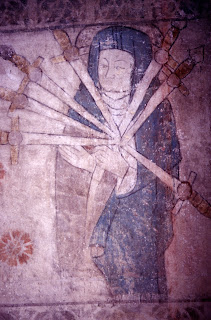"Pietà" by Rainer Maria Rilke
Jesus' sexuality is a difficult issue for Christians. I still remember when I was a young theology student in the late 1980's, at the time of Martin Scorsese's Last Temptation of Christ. Outside the movie theater there were pious believers giving tracts that told that the movie was wrong. What was particularly abhorrent for conservative Christians was the episode where Jesus married Mary Magdalene and raised a family. In the movie it was just a dream of the Christ at the cross, a vision of the life of an ordinary man he could have had. Scorsese, or Nikos Kazantzakis, whose novel the movie was based on, did not claim it to be true. Nevertheless, the very idea of Jesus having sex - or even thinking about it - was enough to raise righteous indignation.
This moral indignation did not appear as theologically wise for the young student. According to the Scripture, Christ was tempted in every way as we are. Does it include sexual temptations? Not necessarily, respond some major theologians. Or, to put it otherwise, does sexuality or sexual desire belong to the full humanity of Christ? In my opinion (then and now) it does.
One of the most beautiful illustrations of erotic love between Jesus and Mary Magdalene is Rainer Maria Rilke's Pietà. The poem depicts the dead body of Jesus as seen through the loving eyes of Mary. There is nothing scandalous in it, the atmosphere is calm, sorrowful, and passionate. As a matter of fact, it is deeply spiritual in its very physicality.
So thus, Jesus, I see thy feet again
As in those past days when thy feet were young
Timidly I unclothed and washed them, - bare - ;
And then they were entangled in my hair
Like a white stag caught in a bush of thorn.
I see thy limbs that love has never known
For the first time on this our night of love
We two together never have lain down;
Now one, adoring, keepeth watch thereof.
See how thy hands are torn - thy gentle hands - ;
Beloved, not by me, not by my kiss.
Thy infinite heart to all men open stands:
O I alone, alone, should have that bliss.
Now thy art tired, and thy tired mouth
hath no delight in my own mournful mouth.
O Jesus, Jesus, when did our hour pass by?
How strangely both of us go down to die.
[transl. Jessie Lemont]
The mulier peccatrix in Luke 7 was early associated with Mary Magdalene. Although it is highly likely that they were two different women, the image of Mary Magdalene as a penitent sinner (or a former whore) has remained prominent in the literature (as in Kazantzakis' Last Temptation). In the feminist reading, this is a problematic setting for Jesus' closest pupil. Peculiar indeed that "a sinful woman" does not, for the most part, mean a violent or greedy woman, but rather sexually immoral (or even sexually active) woman.
For Rilke, at any rate, the figure of Magdalene provides a person with a warm and sensuous set of mind. The scene in the house of the Pharisee was awkward for the men who were present. The way Mary touched Jesus' feet was inappropriate for anyone else but Jesus. The first stanza of Rilke's poem looks back at that moment. It is a precious memory for Mary, who recollects how she unclothed (entkleidete) Jesus' feet and how his hairy feet entangled in her hair "like a white stag caught in a bush of thorn" - an image that is erotic and prophetic at once.
Those who feel offended because of this kind of erotic approach to the dead body of Christ need to hear that Rilke does not imply that Jesus and Magdalene have had a sexual relationship. Jesus' limbs are "never made love with" (deine niegeliebten Glieder) and Mary and Jesus have "never lain down". The tragedy of Magdalene is that the night of love is now, as Jesus has died. This is the night of the unfulfilled love: Mary finally embraces her loved one, but with utter despair.
The great theme of Christian theology, the redemption of humankind, is intertwined with Magdalene's love. As much as she would like to have Jesus completely as her own, Jesus' heart belongs to all humans (Dein Herz steht offen und man kann hinein: das hätte dürfen nur mein Eingang sein.) Before this universal view there is a baffling simile: the pierced hands of Christ are likened to the gentle nibbles between lovers: dein Hände sind zerrissen - ; Geliebter, nicht von mir, von meiner Bissen.
In the end, Mary Magdalene is like anyone who mourns her loved one. Rilke depicts the erotic Good Friday, as it were. Actually, he makes Magdalene to a fellow sufferer of Christ, the one who surrendered her love for Jesus for the benefit of mankind. In my opinion, there is something deeply moving in this picture.



Comments
Post a Comment